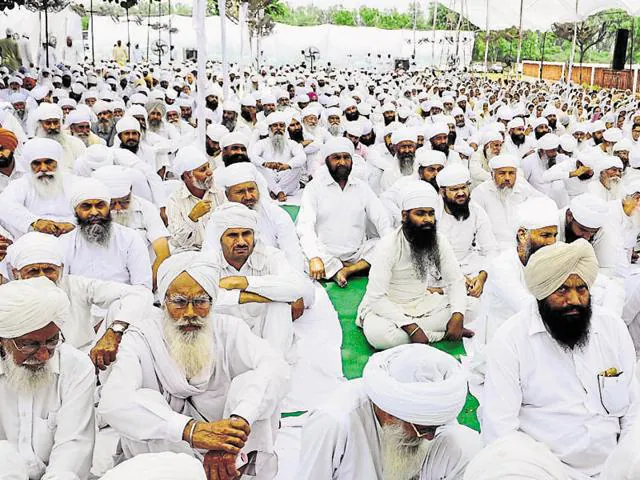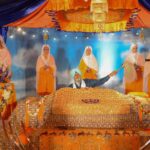Sikhism is a vibrant religion that encompasses various sects and traditions. Two significant sects within Sikhism are the Namdhari (also known as Kuke) and Amritdhari traditions. This article aims to provide a comparative analysis of these two sects, exploring their origins, beliefs, practices, and contributions to Sikhism. Understanding the unique characteristics of each sect will shed light on the diversity and richness of Sikh religious practices.
The Namdharis, also known as Kuka and Kukaism(Gurmukhi: kk [sg]; kk [pl]: from Punjabi kuk, “scream” or “cry”), are a Sikh group that differs from mainstream Sikhs in appearance and theology. Namdhari is Gurmukhi for “bearers of the name”; Devanagari for.”
Appearance
Because of the way the turban or “sidha pag” wrapped across the forehead in the past, the Kuka or Namdhari Sikh is known as someone who wears one. This turban’s design has been compared to an older, more traditional turban. They wear a white woolen cord (mala) that is strung around their necks and acts as a rosary. The mala is made up of 108 knots.
Namdhari Sect
The Namdhari sect, also referred to as Kuke, was founded by Baba Ram Singh in the mid-19th century. Baba Ram Singh sought to restore the purity and simplicity of Sikhism, emphasizing adherence to the teachings of the Guru Granth Sahib, the holy scripture of Sikhs. The Namdharis place great importance on the concept of nam simran, or constant remembrance of God’s name.
The Namdhari sect has distinct visual identifiers, including wearing white clothes, white turbans, and uncut beards. They also abstain from alcohol, tobacco, and meat consumption. Namdharis emphasize a disciplined lifestyle focused on spiritual devotion, selfless service (seva), and social welfare. The Namdhari sect has made notable contributions to education, healthcare, and community development.
Amritdhari Tradition
The Amritdhari tradition, also known as Khalsa or initiated Sikhs, traces its origins back to the creation of the Khalsa by Guru Gobind Singh, the tenth Sikh Guru, in 1699. Amritdhari Sikhs undergo the initiation ceremony known as Amrit Sanchar, where they partake in the Amrit (sweetened water) and accept the vows of the Khalsa. This ceremony is a significant milestone in their spiritual journey.
Amritdhari Sikhs strictly follow the “Five Ks” or Panj Kakar, which are external articles of faith representing the Khalsa identity. These include Kesh (uncut hair), Kangha (a wooden comb), Kara (a steel bracelet), Kachera (special undergarments), and Kirpan (a ceremonial sword). The Amritdhari Sikhs also adhere to the code of conduct known as the Rehat Maryada, which guides their everyday lives.
The Namdhari Sikhs hold that Guru Gobind Singh was not the last of the Sikh Gurus and that he managed to flee from Nander rather than die there. They acknowledge Balak Singh (1797–1862) as the 11th Guru of the Sikh faith, carrying on the line of Sikh Gurus that dates back to Guru Nanak Dev and continues now. The Namdhari community does not eat meat, drink alcohol, or use narcotics, and each member is given Amrit at a young age. Ram Singh (1816–1855), the sect’s 12th Guru, relocated the sect’s headquarters to Bhaini Sahib (Ludhiana) and is recognized as the first Indian to employ boycotting and non-cooperation to fight the British Empire in India.
The Namdhari Sikhs hold that Guru Gobind Singh was not the last of the Sikh Gurus and that he managed to flee from Nander rather than die there. They acknowledge Balak Singh (1797–1862) as the 11th Guru of the Sikh faith, carrying on the line of Sikh Gurus that dates back to Guru Nanak Dev and continues now. The Namdhari community does not eat meat, drink alcohol, or use narcotics, and each member is given Amrit at a young age. Ram Singh (1816–1855), the sect’s 12th Guru, relocated the sect’s headquarters to Bhaini Sahib (Ludhiana) and is recognized as the first Indian to employ boycotting and non-cooperation to fight the British Empire in India.
Comparison and Contrast
While both the Namdhari and Amritdhari traditions are rooted in Sikhism, they differ in their origins, practices, and beliefs. The Namdhari sect emerged as a reformist movement seeking to restore Sikhism to its original ideals, while the Amritdhari tradition traces its roots back to the Khalsa created by Guru Gobind Singh.
In terms of appearance, Namdharis wear white attire as a symbol of purity, while Amritdhari Sikhs maintain uncut hair and wear the Five Ks to reflect their commitment to the Khalsa identity. Both sects place great importance on spiritual devotion and social welfare, but the Namdhari tradition emphasizes nam simran, while the Amritdhari tradition focuses on the Amrit Sanchar ceremony and adherence to the Rehat Maryada.
Despite these differences, both sects have played significant roles in the development and preservation of Sikhism. The Namdhari sect has contributed to education, healthcare, and community development, while the Amritdhari Sikhs have historically been at the forefront of defending Sikh values and traditions. Both traditions have produced prominent religious leaders and scholars who have made invaluable contributions to the Sikh community.
Conclusion
The Namdhari and Amritdhari traditions within Sikhism represent unique expressions of faith, reflecting the diverse spiritual tapestry of the Sikh community. While the Namdhari sect emphasizes nam simran and simplicity, the Amritdhari tradition upholds the Khalsa identity through the Amrit Sanchar and adherence to the Rehat Maryada. Recognizing and appreciating the distinct characteristics and contributions of these sects enriches our understanding of Sikhism as a dynamic and inclusive religion.








